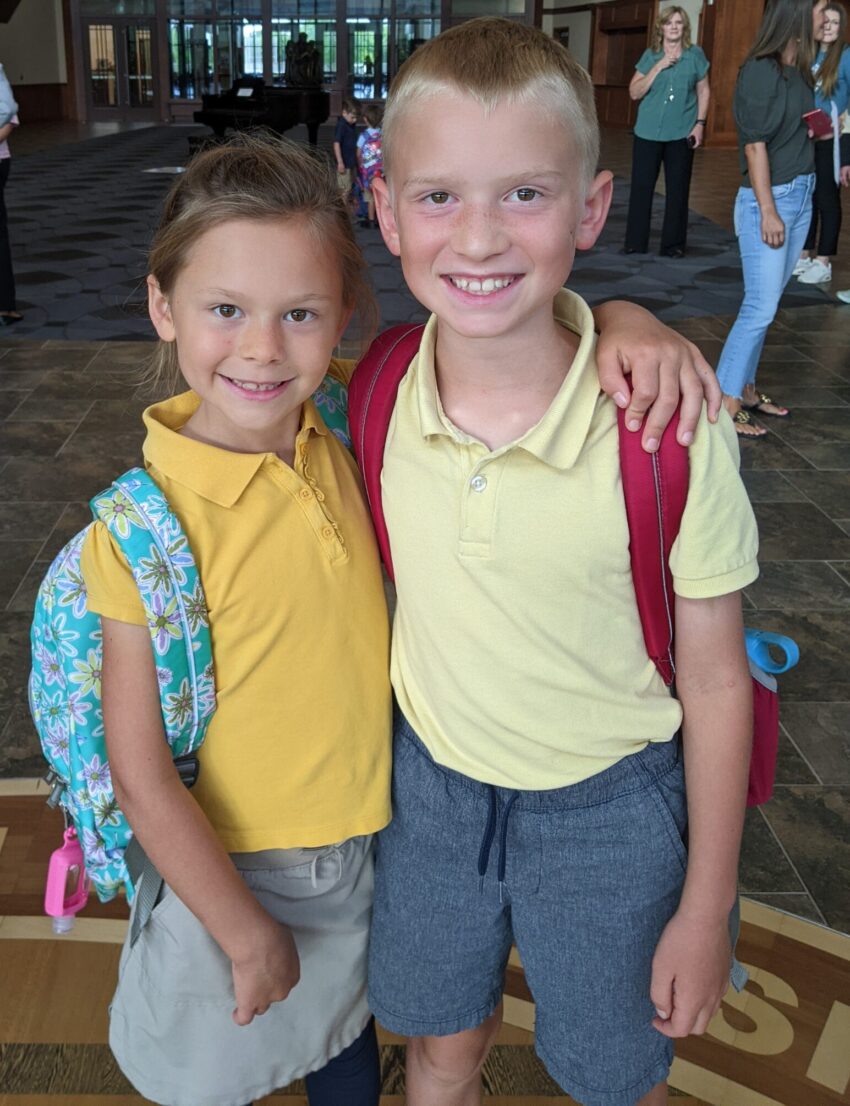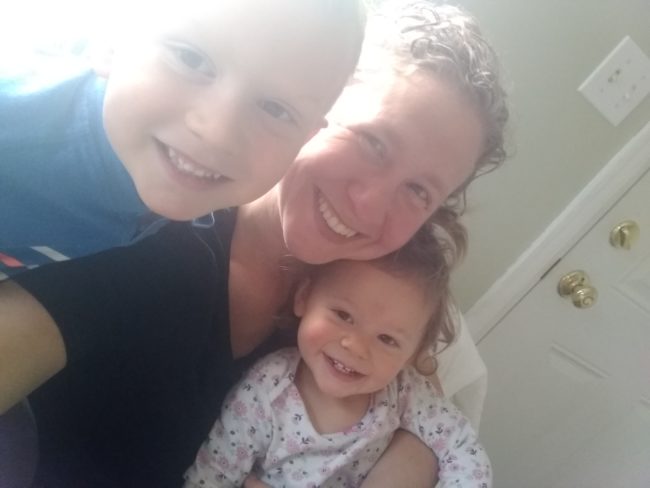
Based on the above pictures, I have been working on this blog post for six years, because that cute one-year-old is starting second grade today!
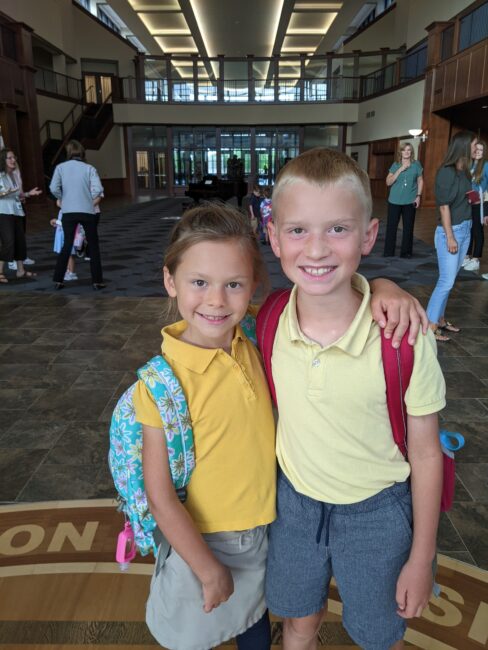
But my slowness to finish this post will mean that you can simultaneously have the opinions, tricks, and advice of a mom of very young children sorting newborn onesies and a mom who has had kids in school uniforms for several years. Or in other words, this is going to be a long post about trying to buy just enough clothes to keep your kids cute, warm, and active, with lots of cute pictures of Jackson and Lily.
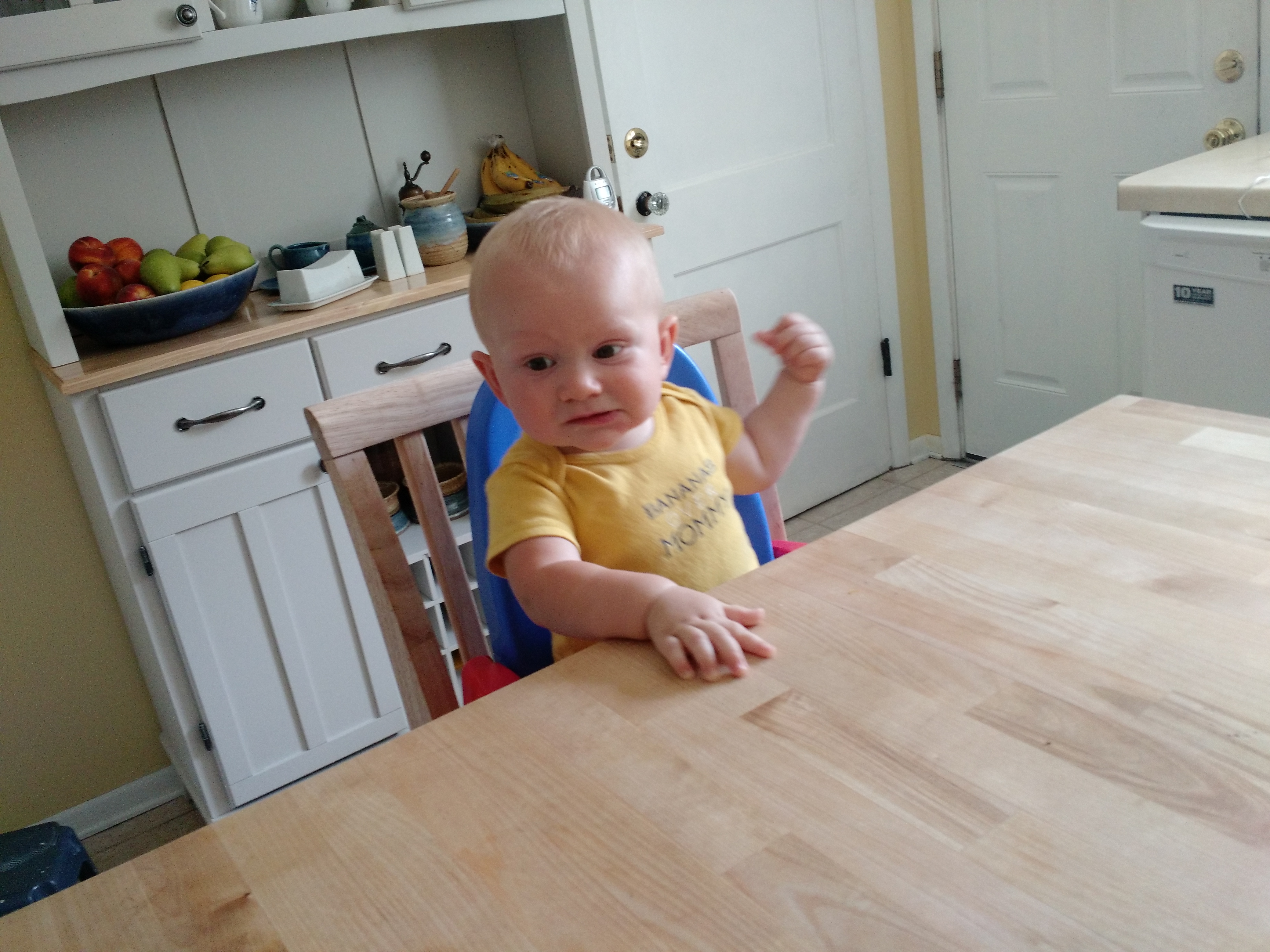
Look baby Jackson in a onesie!
First 20 general thoughts on kids’ clothes and then on to the lists!

#1 Lists are going to be regionally specific!
We live in Wisconsin with air-conditioning. So this list has more cold-weather clothes than hot-weather ones. I know that if we still lived in Maryland, this list would have a lot more shorts and hot weather gear and a bit less snow gear.
If you live somewhere hot, buy more shorts. If you’re not sure how your climate impacts how many of something you need, ask a friend who has slightly older kids and make notes of what you used one season to help you know what to buy the next year.
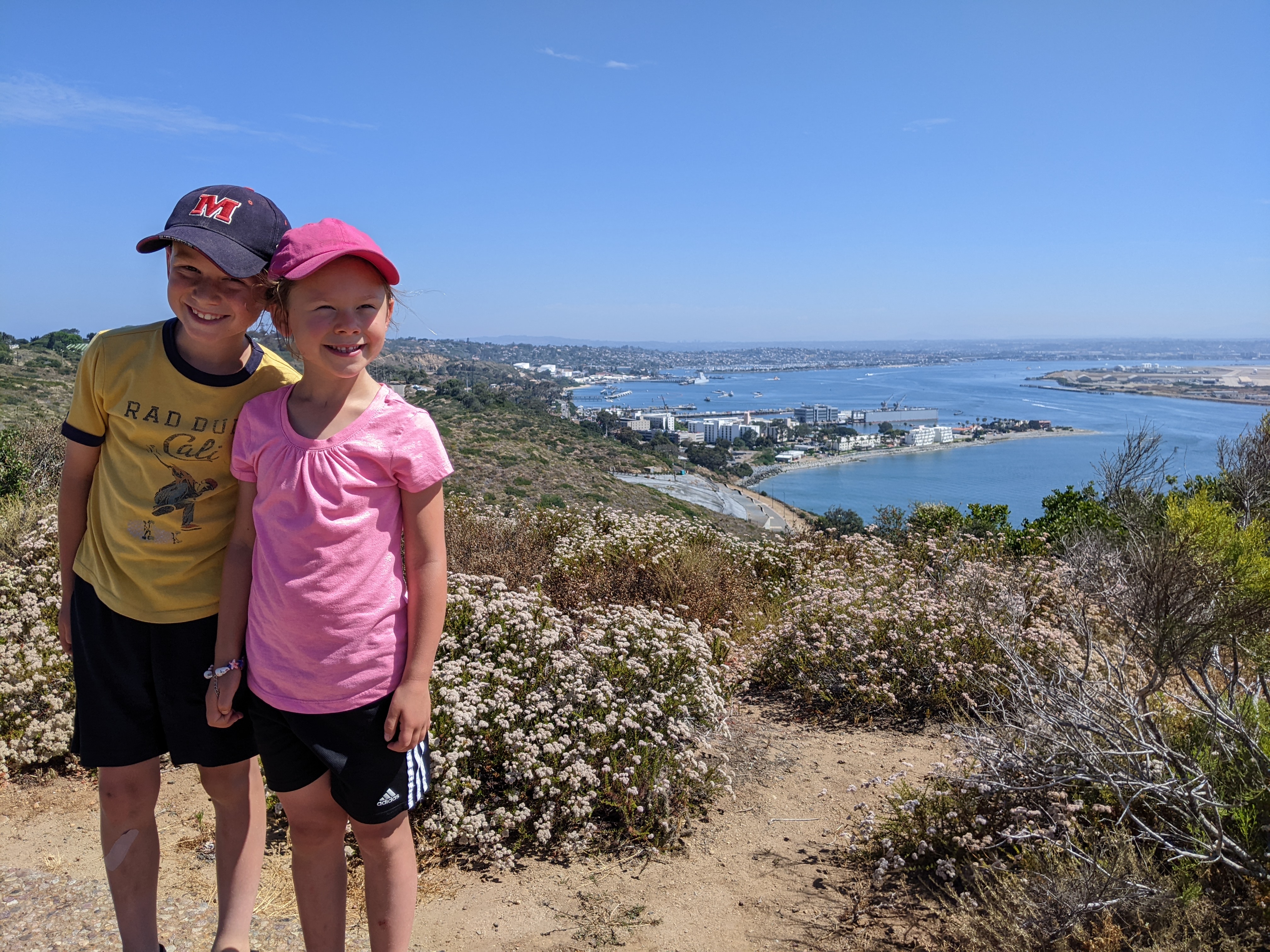
#2. If you need hand-me downs, just ask around!
Generally people whose youngest kid is a little older and taller that your kid of the same gender. I find that about a third of people will say yes. Be ready with several bins and places to store clothes that don’t fit yet, and don’t be afraid to pass along things that don’t work. I like to go through the clothes right away when I get them, giving away the things I don’t like, and organizing them by size.
Our godson is five years older than our son, and his mom saves everything for us. It’s amazing, but you need storage bins! We have also had several teacher-moms from Evan’s school who have given us some great girl clothes. Mark the storage bins with size, season, and gender. And no matter how well you think you remember what is in a bin, make sure you go through the bin before you go and buy new clothes. Ideally, the order of getting new clothes is
- 1.) clean out the closet of old clothes
- 2.) check the bins for what you have
- 3.) go thrifting for what you don’t have
- 4.) buy new from an in-person or online store for what you couldn’t find second-hand.
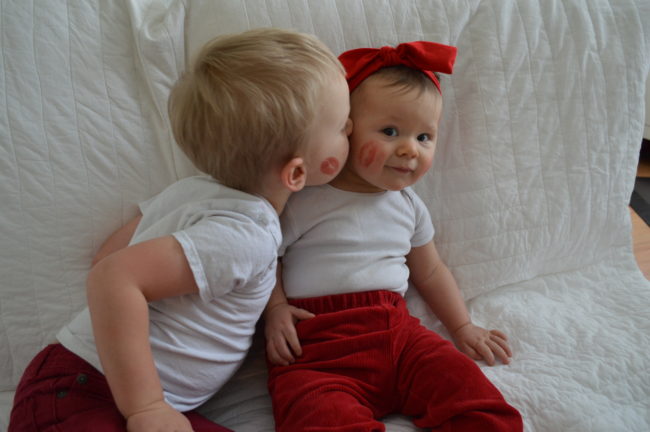
#3. When in doubt, 3 is usually enough.
How many clothes you need depends on several things. We probably are on the “fewer” clothes side of things. We got a lot of hand-me-downs for Jackson, and I like to do laundry daily, and our second child is a girl. We are hard on our clothes, and our clothes are mostly used up by the time someone has outgrown them. If you have a bunch of children and hope to pass along more, you might want a few more pairs of clothes so they last. I find that for many things, when in doubt, 3 is usually enough: one to wear, one to wash, and one to spare.
But again, I do laundry a lot (pretty much daily) and I don’t have kids who like to do recreational change clothes. Also my kids never took to wearing bibs, and I just didn’t care about light stains or keeping clothes in pass-down condition. So, depending on your laundry frequency, number of kids down the line, and play-clothes versus out-and-about clothes needs, and seasonal weather, you might have a bigger baseline number of clothes (especially of t-shirts, socks, and underwear. My baseline for these is probably 6 to 10).

#4. Go for plain navy and khaki pants
I think navy and khaki pants are the easiest to pass between brothers and sisters (black or gray work too, but I found more things for kids match with navy blue right now for some reason). One of the things about a minimalist wardrobe is that you are necessarily going to wash things more, and wear them out more quickly. But since kids grow so quickly, this often isn’t an issue. Also, keeping the number of items down can create room in the budget for buying the exact right thing, as opposed to making four close-enough items work for the next child.
I didn’t worry much about passing down clothes, but plain navy or khaki pants, grey or navy fleece pants, black snow pants, white socks, and white undershirts or blue and white striped shirts ended up being the easiest. If I were really trying to build a wardrobe that could be passed down between brothers and sisters, I’d probably try to get neutral-colored things at Primary.com or HannaAndersson.com.

#5. Invest in accessories in colors that match and go with lots of things.
You want to have bows, tights, undershorts/diaper cover, shoes that go with everything. This is especially true for little girl stuff. It’s fun to have little dresses, but such a (expensive) hassle to have to make up the other half of an outfit. So I like to go with plain white or light pink colored tights/sweater/bows/or shoes that go with everything (I love pink all-star converses for toddler girls because they are cute enough for a casual dress), or one white lacy diaper and a nice white cotton cardigan cover is great.
Occasionally, for tiny babies, I had footie pajamas in a solid color that I would put under a more summer dress to make it stretch to winter. (Also, buy hair bows to match the clothes, so you don’t have to buy a special outfit that matches the bow! I bought this beautiful set of coral/peach/beige/forest green bows, and all the hand me down girl baby clothes I had were bright pink, pink, pink. See end of post of little girl hair accessory ideas. )
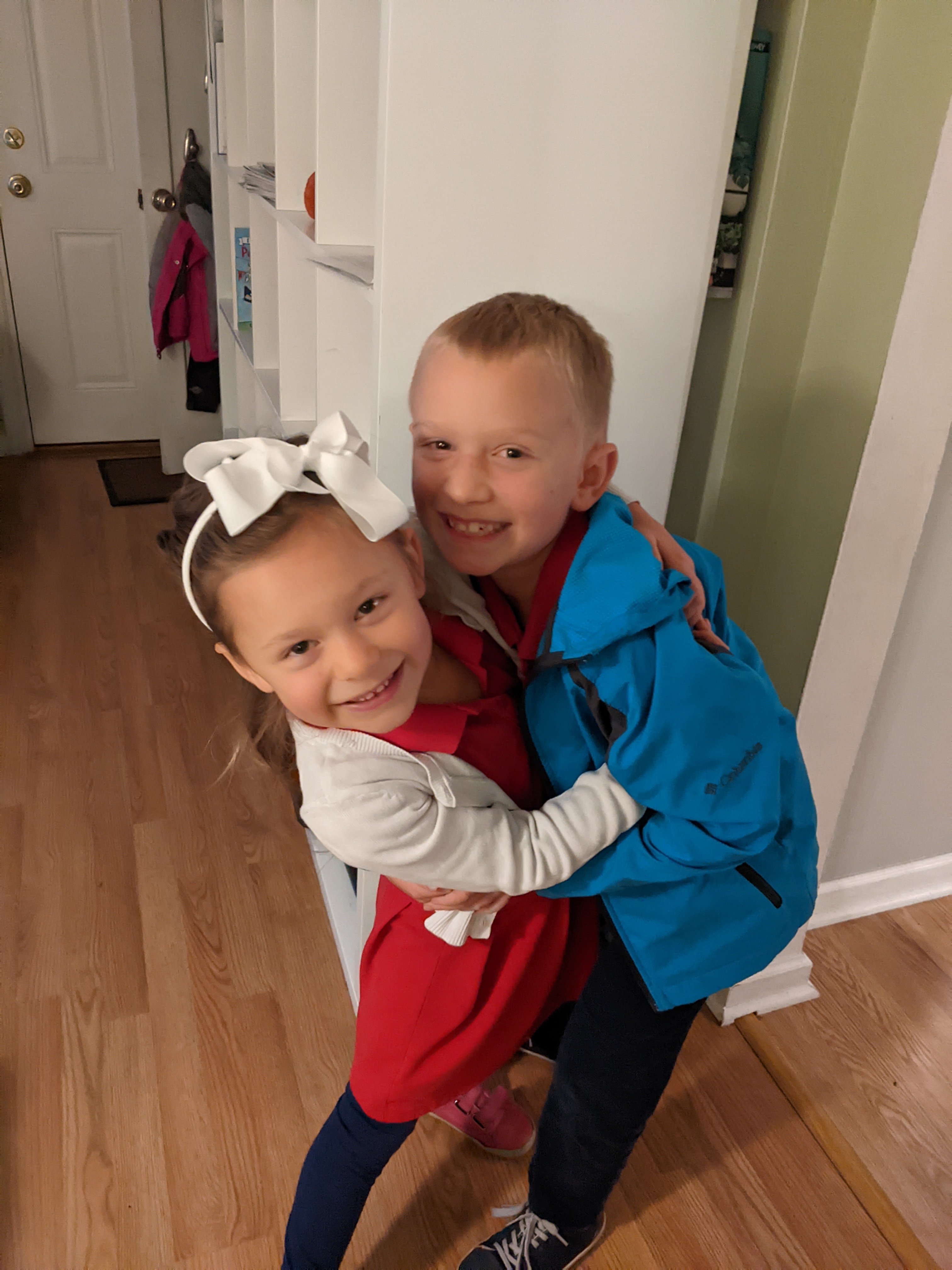
#6 Shoes.
Personally, I didn’t put my kids in shoes until they were walking outside on things that might poke them, so I liked those cute socks that look like shoes for church and other cute outfits. When they did get into shoes, I tried super hard to make them zero drop and flexible soles. Anya’s List is a really helpful resource for this.
When they were tiny, I loved to find a pediped shoe sale and go for that, or converse all stars and take out the inserts (tie ones are a hassle to put on, but babies can’t take them off and lose them on a walk, so I like tie ones until they are two because they can’t take them off themselves and throw them out of the stroller.)
When my kids got bigger ten littles became available, and we’ve had good luck with their classic everyday shoes for school. Now, usually we do Splay! shoes for gym class, and they become the summer go-to shoes. We’ve also had good experiences with the more affordable Whitin shoes.

#7. Mix and Match Colors in Seasonal Collections
If you are buying a whole set of kids clothes, go for an easy mix and match seasonal collection that already is complimentary colors. Usually this is going to be a set of solid bottoms and some print or patterned tops in about four colors (For example, Simple Joys by Carter’s: light pink, light mint green, dark pink, and navy or gray, light blue, and navy).
Sometimes people will suggest that you pick colors and styles before you build a capsule wardrobe. I think if you are buying most things new, that will work great. If you are trying to buy mostly used items, you might want to go with more traditional or primary colors (or at least colors that have been in style for the past 20 years).
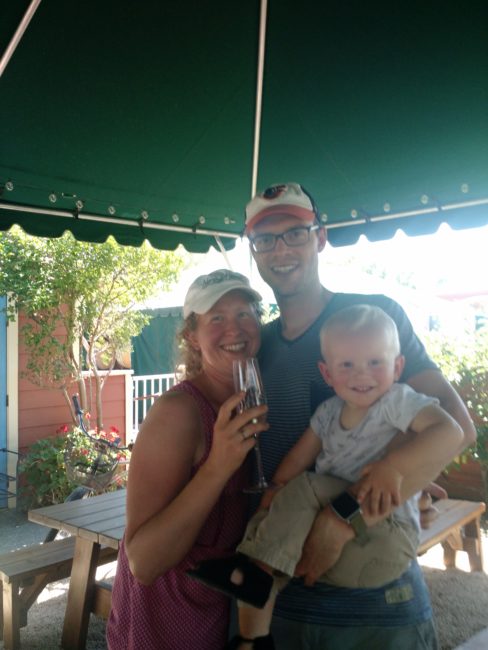
#8. Toddler Summer Pants
For young toddlers, if they’ll tolerate it, durable, lightweight khaki pants work well with Wisconsin summers to prevent skinned knees. The ones from Target are great. Also, shorts seem to be one of those things that don’t wear out, and we are always swimming in hand-me down shorts that rarely get used. Just remember, 75% of the time the kids wear them, they skin their knees within 20 minutes of putting them on.
Starting around four, they do fall less. By four, Jackson started preferring shorts; he hated to be hot, and generally had more opinions about what he wore (i.e. wanting to wear what his friends wore) and started being in shorts more.
Also, I find that buying new (or new to me) pants and long-sleeved shirts in the Fall slightly large, means that by Summer I can make cut-off play clothes out of them. (Just get a good pair of fabric scissors, and only use them to cut fabric!)

#9. For winter clothes, a good option is 100% polyester fleece.
If wool base layers for winter are out of your price range, for for 100% polyester fleece.. I’d pair the fleece either underneath cotton pants or snow pants on top. Fleece is warm and doesn’t get very wet, so it’s great under rain gear. (The best rain gear is the OAKI Rain and Trail suit. It’s expensive, but buy it big and cinch it up. We’ve had three: size 2, size 5, size 8/9. Yellow works the best for boys and girls.)
On very windy days, you need another layer. I found that dark colored fleece looks nicer longer than light colored fleece, that can quickly look dingy after a couple of washes. I love head brajd mittens, for mittens that actually work. (Often you can get these in early fall at Costco.) Jackson’s hands would get so sweaty in these mittens that I always had to turn them inside out to dry when we’d come home. (If you want more ideas on taking babies on winter walks, check out this post.)
Boys’ navy fleece pants seem easier to find than girls’. We’ve had good luck with the brand Carters. Just make sure it’s not a cotton blend if there is a chance of getting wet. And a fleece hoodie is worth investing in, NorthFace or Columbia is spendy but very nice. Again, buy it big to last for 2 or 3 seasons.

#10. Hand-me-downs from babies who were born in the same season
Get clothes from people whose babies were born about the same time of year. I didn’t understand what people were talking about babies being “off seasons” when I was asking for clothes for Jackson, but what that means is that I got only tiny summer clothes for my November baby who was way too big for those summer clothes by the time summer rolled around 9 months later. (Hence, why having a godbrother who had an October birthday was so great). This is very important the first year, but usually by age 2 clothes are lasting a lot longer and is less of an issue.

#11. Having loose enough clothes is important for self-dressing.
Jackson was very slow on self dressing. It really wasn’t until he was four that he really was motivated to get himself dressed, and that was only after having “races” against Lily (and me) to get on each piece of clothes. Lily was much more interested in early self-dressing. (How We Montessori Blog has some great pieces on independent dressing). Remember, just because YOU as an adult can get the pants or underwear on, doesn’t mean kids can. Also no one wants to get their head stuck in a too tight collar. As a general rule, if I can’t get something on my kids fairly easily with just one hand, they are probably going to struggle to get it on with their two little hands.

#12. Have an easy system for pulling aside too small clothes.
Keep an accessible (like in the kids’ closet) empty drawer or bin for too-small clothes. Then put too-small, clean clothes there. Every few months, I sort those clothes into keep and give away. If I had enough time, I’d put baby clothes I’m giving to friends in a labeled gallon ziplock bag (ex, 6-month pants –4 pairs), otherwise everything can just go in a paper bag and they can sort them. For more ideas, The Lazy Genius Podcast has a great episode (#116) on dealing with kids’ clothes!

#13. Aim for half full kids drawers.
It’s easy for kids to put their own clothes away and find their clothes without it being a big mess if there drawers aren’t stuffed. This is generally a good storage philosophy for kids’ stuff in general, even though I have to fight my general proclivity to over-stuff everything.
The kids and I all have cube storage from Ikea and Target’s threshold line with 13 inch fabric bins. (Mostly 1/2 size ones, which I think might be discontinued, and do have the significant drawback of tiny choking hazard pegs to hold up the floating middle shelf. I superglued them, and it’s made life much better for everyone.
I think a wire basket like a Jonaxel or ClosetMaid would also work well) From the start, I’d suggest using Kids’ size (not baby!) Velvet, Non-Slip Clothes Hangers 11″ and having a folding step stool in the closet. I think the best clip hangers for pants are the ones that come with the clothes from Target!

#14. Some things are easy to get as gifts or thrifted.
For example, in my experience, don’t buy 3-month-old cute baby outfits, because people LOVE to give you 3-month-old outfits unless you specifically ask them to buy bigger clothes. Also, don’t buy new boy dress shirts or shorts — those are usually very easy to get as hand-me-downs or thrifted because they aren’t worn out much. (In our hand-me-down bins, we had 18 pairs of 3T shorts. Eighteen! And guess how many we passed on? All 18.)
On the other hand, jeans, pajamas, shoes, socks, and winter coats after age 9 months are hard to come by because the knees, toes, or zippers are worn out. And unless you keep a very detailed list, always check in your bins before you go shopping, it’s very easy to forget what you have in there.
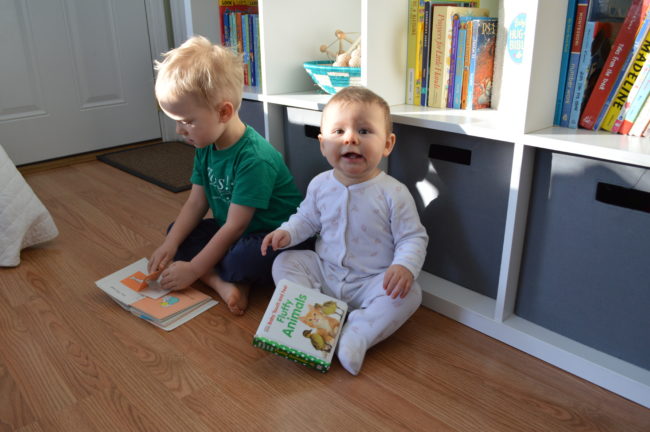
#15. Pajamas.
Here is my advice on pajamas: footie jammies until 6 months, rompers without feet until 12 months, two-piece pajamas at 2 years, and avoid polyester and flame retardants. When Jackson hit 9, we switched him to sleep shorts and undershirts. Before six months, you want warm feet; you can even put socks underneath for extra warmth. After six months, you want your kids to be able to not slip as they learn to walk and stand. And at 2 years, you want your kids to be able to pull down their pants to go potty. Also, polyester flame retardants are yucky, and my crunchy mom side doesn’t like them; organic cotton is ideal if you can manage it.

#16. Dresses
Here is my advice on dresses: Short-sleeved dresses + cardigan in winter, undershorts or diaper covers, and shorter dresses for crawling. I thoroughly enjoy all the little girly things that come with having a daughter as a second child: it’s fun to put on a church dress. I found that short-sleeved cotton jersey dresses are the most versatile. If you buy them on the big side, they last a long time, through hot and cold seasons. Add a cardigan for winter (with the added bonus if they are running around or the heat is really cranking inside, you can take off the cardigan), and when they get bigger, the dress can become a peasant top to pair with leggings.
To help Lily know when we had to transition a dress to a shirt, we made up the rule that a dress is longer than where your fingertips hit your leg. For babies, underneath the dress, a diaper cover is great (a white one should go with most things, although sometimes dresses come with matching ones), and I’ve found white shorts work well too. There can be an awkward stage around 6 to 9 months where crawling in dresses can trip babies up, so either make sure the dresses are short, or skip them all together for a few months. For big girls, I would just repurpose leggings that had knee holes in them into undershorts with good fabric scissors.

#17 When to Buy New Things? Fall.
While there is a good amount of wisdom to waiting until you actually need something to get it, I have found that it can work well to plan big wardrobe purchases more in the Fall. (Plus there are back to school sales and Black Friday sales!) If you buy roomy long-sleeved and long pants items in the fall, that allows room for layering (long underwear underneath, our favorites are from Costco). Then by the following summer time, when those items are a bit snug and worn out, those same outfits can become cut-off shorts or t-shirts for playtime (or under shorts for dresses). Also, you can pair bigger purchases with holidays. (We get new boots as a part of our St. Nicholas Day presents–with a good book and yummy orange spice scones!)

#18 Be able to do some basic clothing repairs.
Being able to put a button back on, or mend a seam is really helpful. I find that mending a knee hole buys me only a few more washes, and patching it even more. I think it’s 100% worth it to invest in some good fabric scissors (again ONLY use them for cutting fabric!) to make cutting straight lines for cut-offs much easier. If you tend to buy your children the same color pants or leggings, save the bottom portions you cut off to make knee patches, and buy some thread in the colors of your kids’ pants.

#19 Boy Short Hair Cuts
I do give my husband, Evan, and son, Jackson, hair cuts at home, with a Wahl Home Haircutting Corded Clipper Kit. Our first kit lasted 15 years. I do the back and sides with a “2” clipper and trim the top with scissors (or an “8” for Jackson which is a little shorter than ideal, but faster). My Aunt Laurie wrote a book in the 1980s that she gave me for our wedding that is helpful. We also use an inexpensive plastic bottle with water for spraying down hair in the morning, like this one.
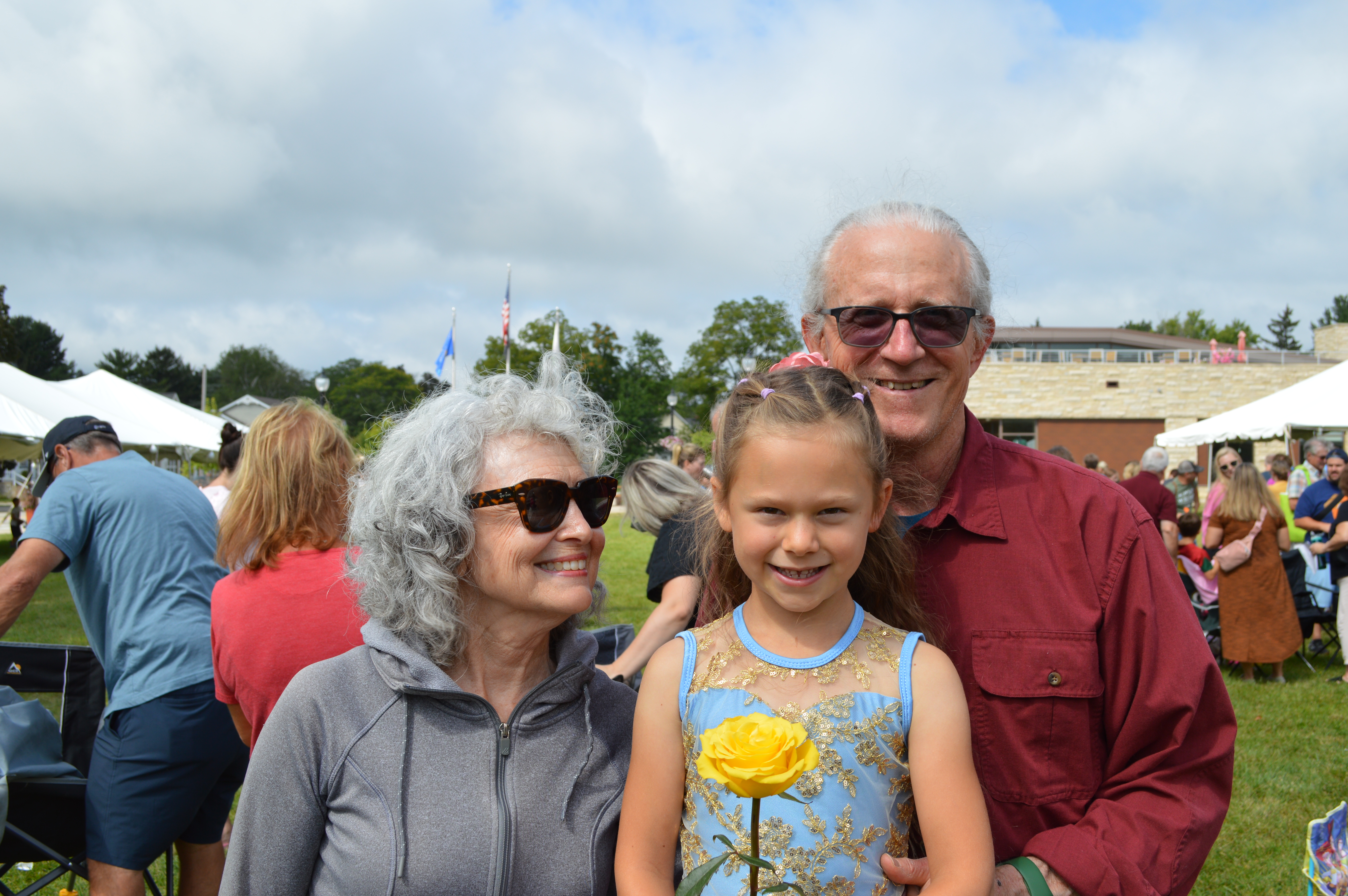
#20. Girls Long Hair Care
- For early Cindy-Lou-Who-esq top of the head pony tails, I like the mini rubber bands. They are pretty much single use, but I found that by the time I was done with one package my daughter Lily’s hair was ready for the next kind of hair tie.
- Once Lily had enough hair we’ve been using a packet of 300 Baby Girls Hair Ties for nearly 4 years. I’d recommend a little zippered pouch to keep them in. Now that Lily’s hair is longer and heavier for a single high pony tail, I like to use two hair ties or one of my own thicker hair ties.
- Wet Brush Kids Detangler Hair Brushes. These are the best. We recently switched over from a different Wet Brush, but this has made life so much better. We use a comb to make a straight part for double French braids.
- Bow Clips in many colors. These small bows have been fun for the ends of braids. And these big linen bows have been fun for larger pony tails.
- Head bands–both soft and hard. We have stretchy hair bands from when Lily was an infant that still fit her. The “hard” headbands Lily likes most (and don’t hurt her head) are the Cat and Jack ones from Target.
Now onto the lists!!

Minimalist Baby & Toddler Wardrobe Lists

Infant to Six Months
- 3 church dresses or outfits w/ nice socks/booties & hair bows
- 3 nice casual outfits w/ socks/booties & hair bows
- 5-8 sleep ‘n play footie jammies
- 3 undershirt onesies & 3 wool socks & 3 sweatshirts or thick sweaters
- 1 Warm Winter Bunting & Hat
You might also want to check out my somewhat organic & minimalist baby registry list and post Learning to Soothe a Baby: a letter to a new mom.

Six Months to One Year
- 3 church dresses or outfits w/ booties & hair bows
- 3 nice casual outfits w/ booties & hair bows
- 5-8 jammies/rompers w/out feet (optional grippy socks)
- 3 undershirt onesies & 3 wool socks & 3 sweatshirts or thick sweaters
- 1 or 2 heavy jeans (not jeggings) to wear outside while crawling
- 1 Bunting & Hat
You might also want to check out My Somewhat Organic & Minimalist List of Favorite Registry Things Toddler Edition and my post Taking Babies on Winter Walks: Tips, Tricks and Gear
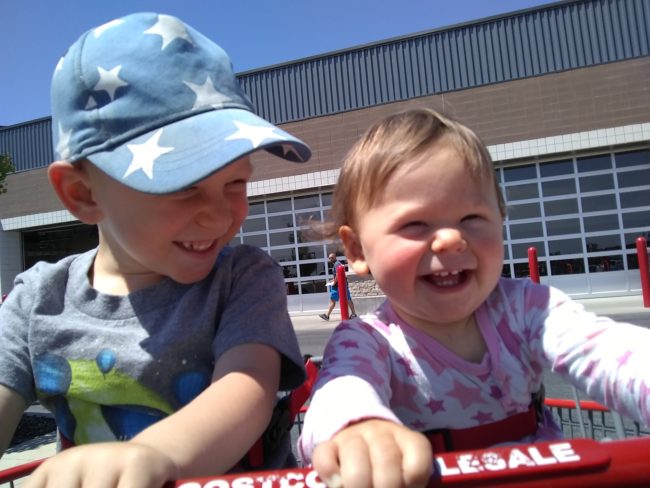
One Year to Two Years
(everything size 2T should be potty training friendly, ie, no onesies or rompers)
- 3 church outfits or dresses short-sleeved w/ cardigans
- 5 long-sleeved shirts & 5 short-sleeved shirts
- 3 fleece pants & 3 light cotton pants & 3 khaki or jeans
- 4 sets of 2-piece pajamas
- 3 wool socks & 3 sweatshirts or thick sweaters
- 1 rain jacket, 1 swimsuit, 1 rain-suit, 1 winter jacket with hood, 1 snow pants, 1 pair of warm mittens, 1 knit hat, 1 baseball hat, 1 buff
- 1 pair converse all-star or ten little shoes, 1 pair slushy bog boots, 1 pair church shoes
- 6 pair training underwear and 6 pairs white cotton socks

Three to Four Years
- 3 church outfits or dresses short-sleeved w/ cardigans
- 5 long-sleeved shirts & 5 short-sleeved shirts
- 3 100% polyester fleece pants & 3 athletic pants & 3 khaki pants ( I also like the Boys Stretch Straight Fit Woven Pull-On Pants – Cat & Jack from Target)
- 4 sets of 2-piece pajamas
- 4 pairs of shorts (3 active pairs, 1 set cargo shorts) (I also like Above Knee Performance Shorts for Boys from Old Navy)
- 3 undershirts & 3 sweatshirts or thick sweaters
- 1 flannel long-sleeved button-up
- 1 zip-up hooded fleece
- 1 rain jacket, 1 swimsuit, 1 rain-suit, 1 winter jacket with hood, 1 snow pants, 1 pair of warm mittens, 1 ski gloves, 1 knit hat, 1 baseball hat, 1 buff
- 1 pair converse all-star or ten little shoes, 1 pair slushy bog boots, 1 pair church shoes, 1 pair sport sandals/water shoes
- 6-10 pair underwear and 6-10 pairs white cotton socks and 6 pairs wool socks
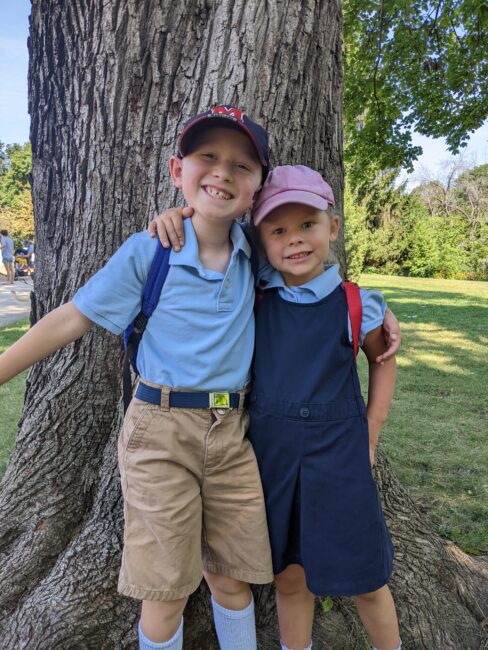
School Years: Uniform Suggestions
Boys:
- 5 pairs of khaki, navy, or gray pants khaki pants ( I also like the Boys Stretch Straight Fit Woven Pull-On Pants – Cat & Jack from Target)
- 3 pairs of khaki shorts
- 5 short-sleeve polo shirts
- 1 sweater
- 1 pair of ten little shoes in navy for everyday wear (half size up at Christmas) and 1 pair of splay! or whitin shoes for gym class
- New pack of six white cotton socks every 4 to 6 months

Girls:
- 6 pairs of leggings (navy, white & pink)
- 3 pairs of cartwheel or under shorts (save leggings with holes in them, use a pair of sharp sewing scissors, and make shorts)
- 3 short-sleeve polo dresses (colors that can go with any leggings)
- 2 jumpers (colors that can go with any leggings)
- 3 pairs of shorts or skirts with built-in undershorts
- 4 short-sleeve polo shirts (navy, pink, white, and light blue)
- 3 cardigan sweaters (navy, pink, and white)
- 1 pair of ten little shoes in navy for everyday wear (half size up at Christmas) and 1 pair of splay! or whitin shoes for gym class

Other kid capsule wardrobe ideas: From WellnessMama.com, RedTri.com, Slow and Happy.com, AnAbundantLifewithLess.com, SuperMomHacks.com, MotherhoodSimplified.com, & MeredithTested.com.
What are your tips and tricks for buying just the right amount of clothes for yourself and your kids?
